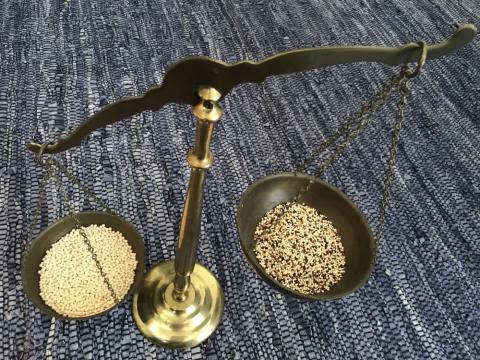
The Scoop on Quinoa:
- Related more to spinach and beets, quinoa is primarily grown for its edible seeds but is considered a pseudo-cereal since it does not belong to the grass family like other cereals do.
- Historically quinoa was first cultivated in the Latin corridors of Ecuador, Columbia, Peru, and Bolivia.
- The quinoa you find in supermarkets is mostly sold after it’s been rinsed of its saponin content. In case you end up buying an un-rinsed one, you need to wash quinoa in ample running water till the “soapiness” is gone -- for this soapiness can actually act as a laxative!
- Quinoa is cooked much like white rice – steamed with double the amount water till the grains and seed split – the grain itself will have a little al-dente bite to it.
- Quinoa leaves or greens are also eaten; however, their availability is limited. Quinoa is much like rice and so can be served in a variety of ways – from stewed quinoa to a side dish, from salads to pilafs.
- There are 229 calories in 1 cup of cooked quinoa with 14% fat, 72% carbs, 14% protein.
- The nutrient composition of quinoa is excellent – it contains essential amino acids such as lysine and is an excellent source of calcium, phosphorus, and iron.
The Scoop on Couscous:
- Not a grain in itself, couscous is actually derived from semolina – semolina is sprinkled with water and then rolled into pellets which are sprinkled with dry flour to keep them separate. This is then passed through a sieve and the process is repeated till all the semolina is pelleted into couscous. Lastly, the pellets are sun-dried.
- Couscous finds its origins in Berber history, in Morocco, Tunisia, Algeria, and Libya.
- The couscous we get in supermarkets is pre-steamed and dehydrated which is why adding 1.5 times boiling water “cooks” it in 5 minutes. In case you get the uncooked couscous, 5 minutes will not do anything.
- Raw couscous is steamed much like rice or like pasta.
- Couscous is best served with a vegetable or meat stew though its use in salads is also popular.
- It has a superior vitamin profile to pasta, containing twice as much riboflavin, niacin, vitamin B6, and folate, and containing four times as much thiamine and pantothenic acid.
- There are 112 calories in 100 grams of cooked couscous with 1% fat, 85% carbs, 14% protein.
The Verdict
Now while quinoa and couscous look very similar, they do differ in nutritional value and you can’t just go by the nutritional values mentioned above. Quinoa is a superior carbohydrate compared to couscous as its glycemic index is 53 which means it doesn’t spike your blood sugar levels. Quinoa becomes great food for anyone with insulin sensitivity. Also, the proteins in quinoa are the ones similar to those in beans – meaning that it is a complete protein and contains all the essential amino acids that you need to build healthy body tissues.
So as tasty and exotic as couscous is, nutritionally it is similar to white pasta – a simple carbohydrate. Quinoa, on the other hand, is nigh well a superfood, especially for vegans and vegetarians who need to get protein into their diet without animal products. So it is quinoa all the way if it’s health that you are after.
If you still love couscous, remember that it has a glycemic index of 65, which is way higher than quinoa. Also, if you have couscous once in awhile, it’s fine, but if you opt for it on a daily basis – remember that it lacks the variety of nutrients found in true whole grains like wheat. When buying couscous, remember to opt for whole-wheat couscous as it is more nutritious than the regular variety since it contains 5-6 grams of fiber per serving, which can help you meet the recommended daily amount of fiber.
Basically, it does boil down to the fact that quinoa makes for a healthier choice, even if couscous makes for a tastier one. Eaten in moderation, there’s no issue with either, and as long as you pile your couscous plate with plenty of veggies, healthy free-range meats, and hold that oil.








